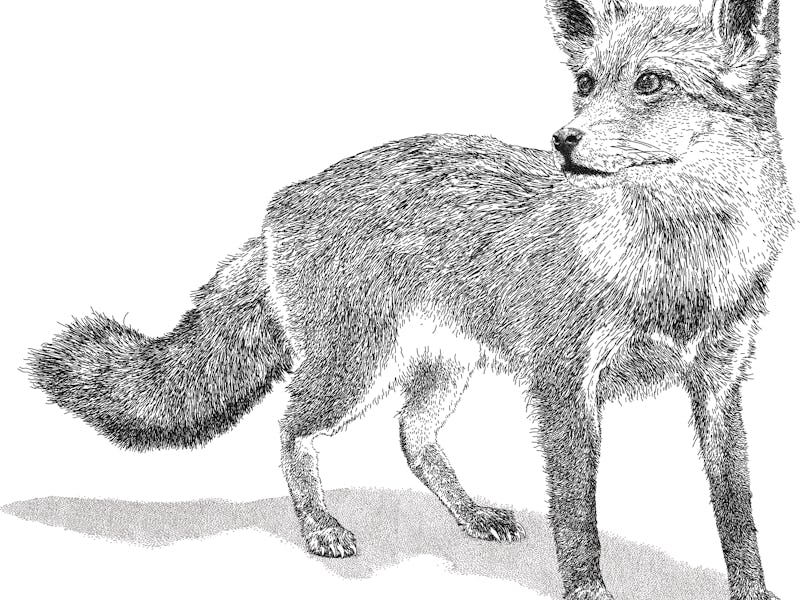Rapid evolution is making red foxes more like dogs in 1 distinct way
"Adapting to life around humans actually primes some animals for domestication."

For more than a century, foxes have been taking over London. There's now one fox per every 300 people in England's capital.
This time spent in cityscapes has led urban foxes to take on new traits, recent research shows. They have become noticeably different from their wild counterparts after only a few generations.
In just over a century, urban-dwelling red foxes, Vulpes vulpes, have developed smaller heads and shorter, wider snouts compared to foxes in rural areas, according to a study published Wednesday in the journal Proceedings of the Royal Society B. The urban foxes also show a less extreme size difference between males and females.
These specific attributes, and the rapid pace of their evolution, suggest that the foxes are changing in a unique way — a process that perhaps involves more than random mutations.
The changes are also remarkably similar to what happened in the early days of dog and cat domestication.
Researchers believe that the different snout shape developed to help city foxes sniff around for morsels of food in human garbage.
"Human activity often results in rapid and extreme environmental variation," the study authors write.
Fox on the prowl at night in London.
For over 100 years, urban foxes have roamed English cities, including Birmingham, Bristol, and London. There are now more than 10,000 foxes in London alone. As a result, those foxes have even shifted their food sources, scavenging as much as 37 percent of their diet.
Since urban foxes tend to stay within their new homes, there's a reduced chance of them mating with rural foxes, the study reports. This means foxes in cities have a better chance of adapting to their local conditions by breeding helpful traits.
To get a sense for how foxes are different in rural and urban areas, the authors of the new study analyzed 111 skulls of adult red foxes from in and near London. The samples were collected between 1971 and 1973 for research characterizing "suburban foxes."
Differences in skull morphology between rural and urban foxes.
These foxes aren't a new species, but researchers think they have what's called "domestication syndrome." Essentially, by hanging around humans so much, these foxes are starting to become more like house pets than wild animals.
Since interactions between human animals are "continuous," the study sheds light on the domestication process that animals more commonly considered as pets underwent, co-author Andrew Kitchener, a zoologist and curator at the National Museums Scotland, explains.
Kitchener says that the basic environmental factors present in early domestication of dogs and cats were "probably similar to the conditions in which our urban foxes and other urban animals are living today."
"So, adapting to life around humans actually primes some animals for domestication," he said.
Could foxes be future pets?
Rapidly changing foxes — The rapid, recent changes in red foxes demonstrate that these changes are linked to fundamental tendencies in foxes, explains lead author Kevin Parsons, a senior lecturer at the University of Glasgow.
And since the changes correlate with skills that help foxes survive in the wild — like digging through trash — they suggest that the rapid evolution might be happening in an unexpected way.
"While the amount of change isn't as big, this showed that this recent evolutionary change in foxes is dependent upon deep-seated tendencies for how foxes can change," Parsons said in a statement.
"In other words, these changes were not caused by random mutations having random effects the way many might think evolution occurs."
The future of the red fox, for now, is uncertain. While their numbers in urban Britain jumped from 33,000 in 1995 to 150,000 in 2017, there was also a 42 percent decline in red foxes in 2018. Foxes have learned how to adapt to urban spaces, but urban spaces are not always friendly to foxes. Time will tell whether people begin to open their doors to the foxes as they once did with dogs — or if they'll continue to populate the streets.
Abstract: Human activity is drastically altering the habitat use of natural populations. This has been documented as a driver of phenotypic divergence in a number of wild animal populations. Here, we show that urban and rural populations of red foxes (Vulpes vulpes) from London and surrounding boroughs are divergent in skull traits. These changes are primarily found to be involved with snout length, with urban individuals tending to have shorter and wider muzzles relative to rural individuals, smaller braincases and reduced sexual dimorphism. Changes were widespread and related to muscle attachment sites and thus are likely driven by differing biomechanical demands of feeding or cognition between habitats. Through extensive sampling of the genus Vulpes, we found no support for phylogenetic effects on skull morphology, but patterns of divergence found between urban and rural habitats in V. vulpes quantitatively aligned with macroevolutionary divergence between species. The patterns of skull divergence between urban and rural habitats matched the description of morphological changes that can occur during domestication. Specifically, urban populations of foxes show variation consistent with ‘domestication syndrome’. Therefore, we suggest that occurrences of phenotypic divergence in relation to human activity, while interesting themselves, also have the potential to inform us of the conditions and mechanisms that could initiate domestication. Finally, this also suggests that patterns of domestication may be developmentally biased towards larger patterns of interspecific divergence.